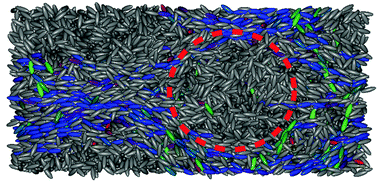Sample preparation affects the nematic–isotropic transition in liquid crystal elastomers: insights from molecular simulation
Abstract
The features of nematic–isotropic transition in liquid crystal elastomers are important for the potential applications of these materials as sensors and actuators. In this paper, we use molecular simulations to obtain insights into the nature of this transition, focusing on the role of sample preparation leading to different polymer network architectures, as well as on the role of swelling. We perform a series of isostress Monte Carlo simulations in a swollen crosslinked system consisting of soft-core Gay–Berne ellipsoids, finding that the smoothness of the nematic–isotropic transition in irregular samples can be attributed to quenched disorder resulting in a distribution of local transition temperatures, and in the strongly swollen samples to a polymer network-swelling monomers phase separation.



 Please wait while we load your content...
Please wait while we load your content...